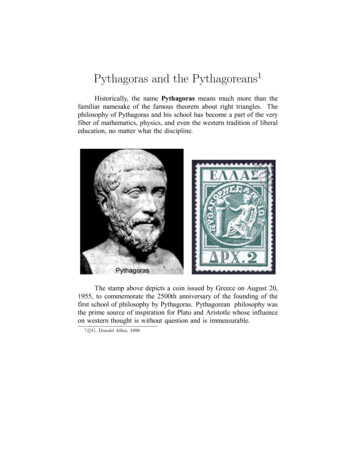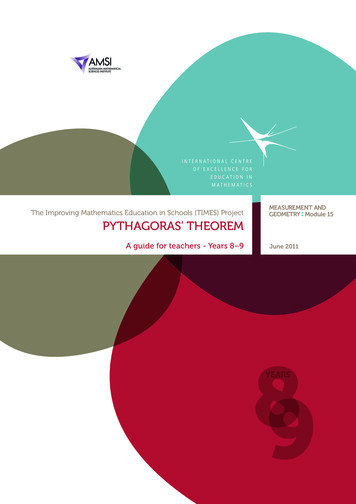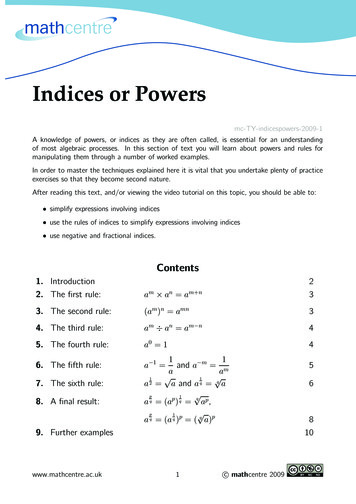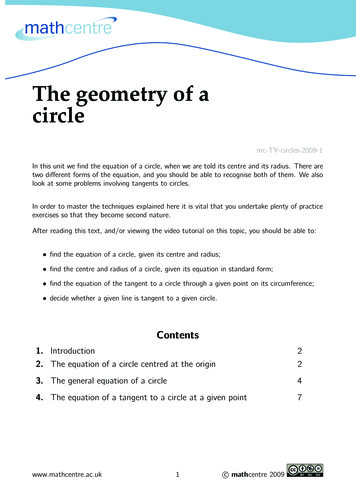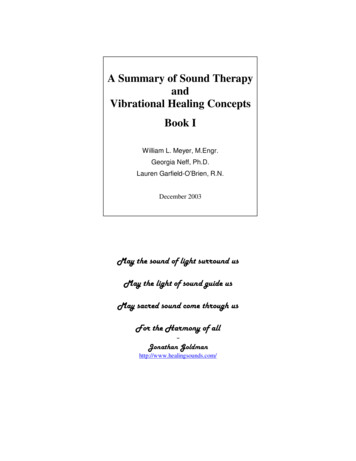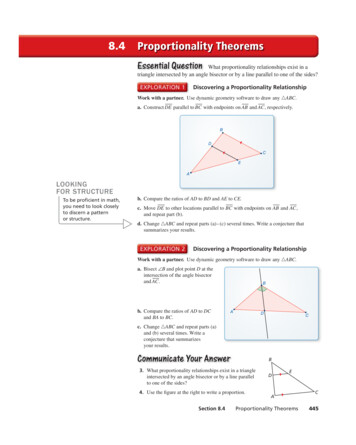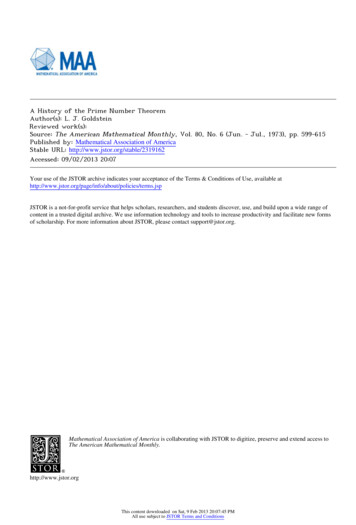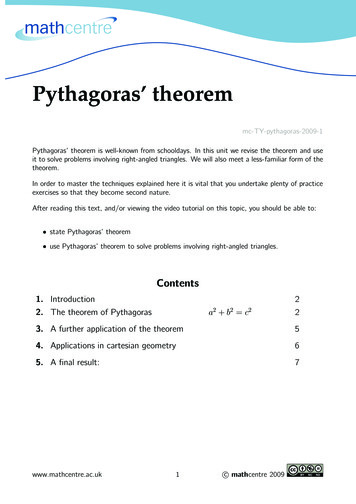
Transcription
Pythagoras’ theoremmc-TY-pythagoras-2009-1Pythagoras’ theorem is well-known from schooldays. In this unit we revise the theorem and useit to solve problems involving right-angled triangles. We will also meet a less-familiar form of thetheorem.In order to master the techniques explained here it is vital that you undertake plenty of practiceexercises so that they become second nature.After reading this text, and/or viewing the video tutorial on this topic, you should be able to: state Pythagoras’ theorem use Pythagoras’ theorem to solve problems involving right-angled triangles.Contents1. Introduction2a2 b2 c22. The theorem of Pythagoras23. A further application of the theorem54. Applications in cartesian geometry65. A final result:7www.mathcentre.ac.uk1c mathcentre 2009
1. IntroductionThe Theorem of Pythagoras is a well-known theorem. It is also a very old one, not only does itbear the name of Pythagoras, an ancient Greek, but it was also known to the ancient Babyloniansand to the ancient Egyptians. Most school students learn of it as a2 b2 c2 . The actualstatement of the theorem is more to do with areas. So, let’s have a look at the statement ofthe theorem.2. The Theorem of PythagorasThe theorem makes reference to a right-angled triangle such as that shown in Figure 1. Theside opposite the right-angle is the longest side and is called the hypotenuse.hypnusoteeFigure 1. A right-angled triangle with hypotenuse shown.What the theorem says is that the area of the square on the hypotenuse is equal to the sum of theareas of the squares on the two shorter sides. Figure 2 shows squares drawn on the hypotenuseand on the two shorter sides. The theorem tells us that area A area B area C.CAcabBFigure 2. A right-angled triangle with squares drawn on each side.An excellent demonstration of this is available on the accompanying video. If we denote thelengths of the sides of the triangle as a, b and c, as shown, then area A a2 , area B b2 andarea C c2 . So, using Pythagoras’ theoremarea A area B area Ca2 b2 c2This is the traditional result.www.mathcentre.ac.uk2c mathcentre 2009
Key PointPythagoras’ theorem:a 2 b2 c 2cabExampleSuppose we wish to find the length of the hypotenuse of the right-angled triangle shown in Figure4. We have labelled the hypotenuse c.ca 3b 4Figure 4.Using the theorem:a2 b23 2 429 16255 c2c2c2c2cSo 5 is the length of the hypotenuse, the longest side of the triangle.ExampleIn this Example we will assume we know the length of the hypotenuse.z 13x 5yFigure 5.www.mathcentre.ac.uk3c mathcentre 2009
The corresponding statement of Pythagoras’ theorem is x2 y 2 z 2 . So,x2 y 252 y 225 y 2y2yz2132169144 144 12 So, 12 is the length of the unknown side.ExampleSuppose we wish to find the length q in Figure 6. The statement of the theorem is nowp2 q 2 r 2r 17qp 15Figure 6.p2 q 2152 q 2225 q 2q2q r2172289648So, 8 is the length of the unknown side.In each of these three Examples, the answers have been exact and they have been whole numbervalues. These whole number triples, ((3,4,5), (5,12,13), (8,15,17)), or Pythagorean triples,as we call them, occur quite frequently. When you do questions like these, you probably won’tbe so lucky to get exact answers as we have done here; you almost certainly will have to usea calculator for many of them and you have to decide to approximate the answer to a givennumber of decimal places or a given number of significant figures.Exercise 11. Determine, to 2 decimal places, the length of the hypotenuses of the right-angled triangleswhose two shorter sides have the lengths given below.a) 5 cm, 12 cm b) 1 cm, 2 cmc) 3 cm, 4 cmd) 1 cm, 1 cme)1.73 cm, 1 cmf)2 cm, 5 cm2. Determine, to 2 decimal places, the length of the third sides of the right-angled triangleswhere the hypotenuse and other side have the lengths given below.a) 8 cm, 2 cm b) 5 cm, 4 cmc) 2 cm, 1 cmd) 6 cm, 5 cmwww.mathcentre.ac.uke)10 cm, 7 cmf)1 cm, 0.5 cm4c mathcentre 2009
3. A further application of the theoremLet’s have a look at another application of Pythagoras’ theorem.Look at the cuboid shown in Figure 7. Suppose we wish to find the length, y, of the diagonalof this cuboid. This is the bold line in Figure 7. Note that ABC is a right-angled triangle withthe right-angle at C. Note also, that ACD is a right-angled triangle with hypotenuse AC. Let AChave length x, as shown.B12yx 5CxA34DFigure 7.Referrring to triangle ACD and using Pythagoras’ theorem:3 2 429 16x2x x2x2255Now let the length of the diagonal AB be y. Using Pythagoras’ theorem in triangle ABC:52 12225 144169y y2y2y2 169 13So we can use the theorem of Pythagoras in 3-dimensions; we can use it to solve problems thatare set up in 3-dimensional objects.Exercise 21. Calculate the length of the diagonals of the following cuboidsa) 2 3 4b) 1 1 3c) 5 5 5Give your answers to 2 decimal places.www.mathcentre.ac.uk5c mathcentre 2009
4. Applications in cartesian geometryCartesian geometry is geometry that is set out on a plane that uses cartesian co-ordinates.These are the familiar (x, y) coordinates you will have seen before. We have already seen thatPythagoras’ theorem gives us a relationship which is satisfied between the lengths of the sidesof a right-angled triangle. However, we can turn this theorem around. If we study any triangle,and find that the area of the square on the longest side is equal to the sum of the areas of thesquares on the two shorter sides of the triangle, then the triangle must be right-angled. So wecan use Pythagoras’ theorem to tell whether a triangle is right-angled or not.ExampleSuppose we have the co-ordinates of three points:(3, 4)(2, 6)(1, 0)Can we use Pythagoras’ theorem to find out whether they form the corners of a right-angledtriangle ? The points are plotted in Figure 8. Looking at Figure 8 we might guess that thetriangle does contain a right-angle, but we can’t be sure. The scales on the two axes are notquite the same and so appearances can be deceptive.yB (2,6)65C (3,4)432101A(1,0)23xFigure 8.From Figure 8 note that(AB)2 2(BC) 12 62 1 363722 12 4 15(AC)2 22 42 4 16 20Now ask the question. Do the squares of the shorter sides add together to give the square ofthe longer side ?(AC)2 (BC)2 5 20 25 6 37So we do not have a right-angled triangle. In fact because the longest side, AB, is greater thanthat which would be required to form a right-angle (i.e. 25 5) we can deduce that the angleat C is in fact greater than 90 . Thus C is an obtuse angle. This is not immediately obviousfrom a sketch.www.mathcentre.ac.uk6c mathcentre 2009
Exercise 31. The lengths of the sides of a number of different triangles are given below. In each case,determine whether the largest angle is obtuse, right angle or acute.a) 1, 1, 1b) 1, 1, 2 c) 4, 3, 2d) 5, 7, 9e)5, 12, 13f) 2, 6, 4g)8, 10, 6h)1, 2, 22. The co-ordinates of the vertices of a number of triangles are given below. In each case,determine if the triangle is right angled.a) (1,2), (2,3), (5,0)b) (2,1), (4,2), (2,6)c) (3,2), (5,1), (2,5)5. A final resultFinally, the fact that Pythagoras’ Theorem is about squares is fairly well-known. What is notso well-known, although it is fairly obvious once you have seen it, is that if you take any regularfigure or similar figures and place them on the sides of a right-angled triangle, then the area ofthe figure on the hypotenuse is equal to the sum of the areas of the figures on the two shortersides. Consider, for example, Figure 9 where we have drawn semi-circles on each side of theright-angled triangle.CBcbaAFigure 9. Semi-circles drawn on the sides of the right-angled triangle.From the formula for the area of a circle:and so1 a 2 π 2 aArea of A π228 21bπArea of B π b2228 2πc1 c2Area of C π228π 2 π 2a b88π 2 (a b2 )8Area of A Area of B But from Pythagoras’ theorem a2 b2 c2 and soπ 2c8 Area of CArea of A Area of B and so it is true that Area of A Area of B Area of C.www.mathcentre.ac.uk7c mathcentre 2009
AnswersExercise 11. a) 13 cm b) 2.24 cm c) 5 cm d) 1.41 cm e) 2.00 cm f) 5.39 cm2. a) 7.75 cm b) 3 cm c) 1.73 cm d) 3.32 cm e) 7.14 cm f) 0.87 cmExercise 21. a) 5.39b) 3.32c) 8.66Exercise 31. a) acute b) obtuse c) obtuse d) obtuse e) right angle f) obtuse g) right angle h) acute2. a) Yes b) Yes c) Nowww.mathcentre.ac.uk8c mathcentre 2009
The corresponding statement of Pythagoras' theorem is x2 y2 z2.So, x2 y 2 z 5 2 y 132 25 y2 169 y2 144 y 144 12 So, 12 is the length of the unknown side. Example Suppose we wish to find the length q in Figure 6.
